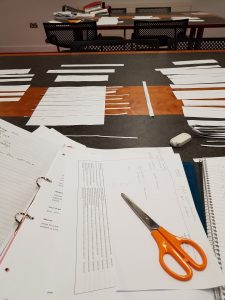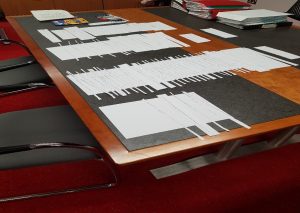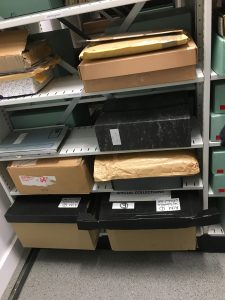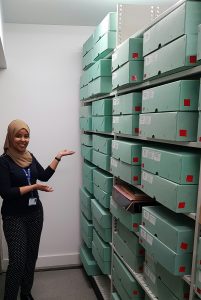Guest post from Hana Noor, a former MA Museum Studies student at the University of Leicester, 2019
As part of my postgraduate course, I had the opportunity to undertake a work placement project over the summer of 2019 in the archives and special collections department. The project involved organising and cataloguing the Association of Independent Museum (AIM) archive collection under supervision from the University archivist. AIM was founded in 1977 to support and represent independent museums located in the UK. Given that the collection had been stored in the library for several years, the goal was to make the AIM’s archive record accessible to potential users of the collection, hence the significance to carry out this project to its completion.
The initial phase of the project involved surveying the AIM’s archive collection and I did this by assessing the papers of the association which were stored in numerous boxes and folders. I had to familiarise myself with the content of the documents to get a rough idea if there were any recurring themes existing in the collection. I then recorded the information on a spreadsheet and gave each box or folder a brief description. Once I figured out the overall structure of the collection and what kinds of records there were, I could then return to this spreadsheet and record the contents of the material, one file at a time. By reviewing the AIM’s archives, I was able to determine that the collection mainly consisted of material relating to the establishment and administration of AIM, which included things like financial documents, agendas and minutes, membership records and fiscal returns, photographs and AIM publications.

Each row, which describes a file or item, is cut up and arranged into groups of similar items, within the catalogue structure.
Vicky Holmes, my supervisor, had suggested a structure for the catalogue divided into three sections: the administrative records of AIM itself, records which reflect the work it did with and for museums, and other related papers. So the next task I had to tackle was to organise the material into this archival system which progressed from the extensive to the more precise. This would take the form of a hierarchy that would consist of a top tier which described the overview of the collection and progressed all the way down to a description of each file. This archival structure was created to assist the development of the AIM’s catalogue and so the finished product could then be uploaded onto the University Archives Calm catalogue.
To do this I cut all of the descriptions I had created up so that I could arrange them within the proposed catalogue structure:

Each column represents a different part of the catalogue, and different series of records, e.g. minutes, membership records, photographs.
To improve and maintain the preservation of the archives I had to also repackage the material into acid-free folders and boxes, from the files and cardboard boxes they were sent to the University in (which you can see in the first photograph), and label them with the correct references, so that they can be fetched to the reading room for researchers to use them.
During the last few weeks of my summer placement, there were two more boxes of AIM archival material delivered. These documents, which included some minutes and publications, were useful since they filled the gaps in the catalogue of items that were thought to be missing. Unfortunately I was not able to complete the cataloguing of AIM’s archival material during my placement period, because it is a big collection, but I was luckily given another opportunity to finish the project once I had graduated and could work on a full-time basis as a temporary archive assistant. My assignment for the duration of this month also included going through the AIM correspondence files and I weeded out any material that could breach data protection regulations. This meant removing things like CV’s and personal letters and making sure that personal addresses were not displayed. It also involved assessing which documents were going to be retained or disposed of, in addition to organising and listing the remaining files into the excel spreadsheet.
The collection of the organisation contained some really interesting early papers and meetings around the founding of the association, such as the 1978 Memorandum and Articles of Association, which could be a great resource for anyone interested in the history of museum/heritage organisations in the UK. The catalogue is available to browse here.
Hanna Noor.



 Subscribe to vholmes's posts
Subscribe to vholmes's posts
Recent Comments